Nightmare Kart is a free fangame that takes plot and visual design elements from FromSoftware’s eldritch horror action RPG Bloodborne and reimagines them as the foundation of a perennial party favorite, the kart racer. For added aesthetic appeal, it also models its polygonal graphics in the style of the 32-bit console era, creating a retro visual style that fits in alongside PlayStation 1 kart racers like Crash Team Racing and Speed Freaks. In a campaign that roughly retells Bloodborne’s story with race karts or in a flexible Free Play mode, I play as a Hunter who speeds through a Victorian kingdom that has descended into cursed madness, fighting off villagers who have been transformed by a blood plague into crazed monsters and fellow Hunters who are even more dangerous than their prey.

Though Nightmare Kart’s developer was asked to change the names of Bloodborne’s recognizable characters, locations, weapons, and collectables before release, all of these elements are still present and immediately recognizable to its diehard fans. Experienced Bloodborne players will recognize their Nightmare Kart counterpart immediately.
Most courses in Nightmare Kart are traditional circuit races set in ravaged Victorian settings like a dark city street, a crumbling graveyard, a dank sewer, a creepy forest, and the decaying gardens outside a posh manor. Successfully completing three laps around the circuit and finishing with no more than two of the driver’s competitors ahead of them wins the race. It’s the chaos that happens during these three laps which makes it challenging and, in the best of times, fun.
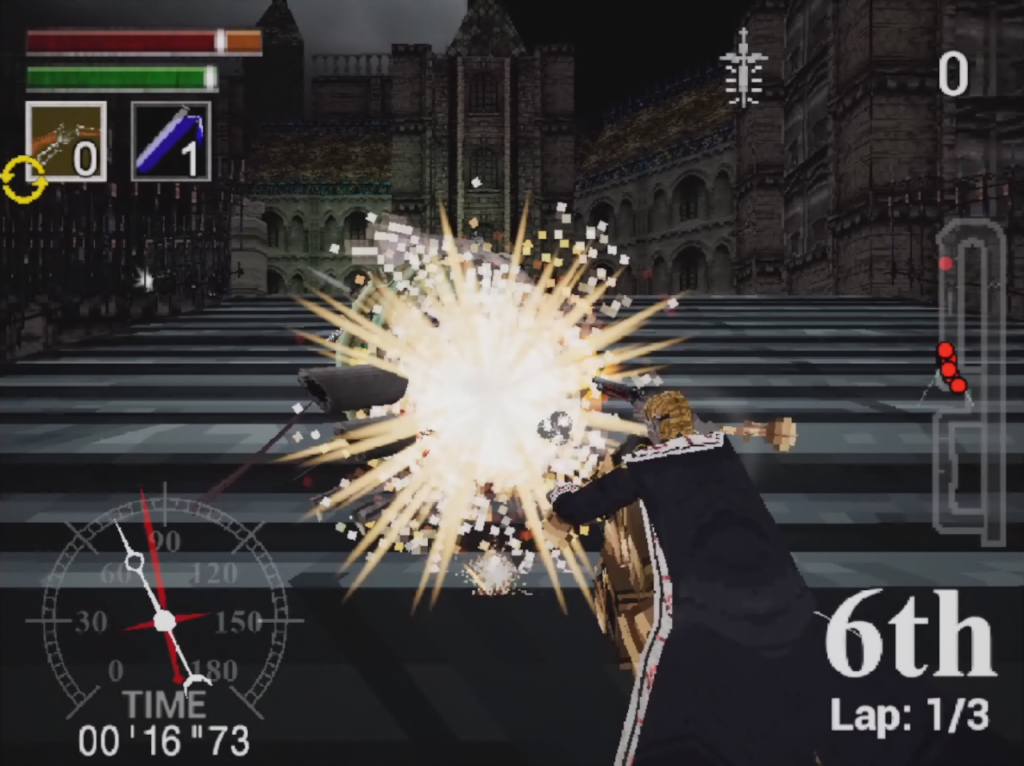
Even for a kart racer, Nightmare Kart is unusually focused on attacking other racers and even the environment with weapons. Drivers are bestowed with a random item or weapon when they drive through the spheres of light that litter each track. Pistols and shotguns automatically aim themselves at nearby targets. Melee weapons include the foldable Beast Razor, the long and elegant Threaded Sword, and the blunt and powerful Crescent Axe, all of which send the driver charging forward before unleashing a powerful swing, tearing into anything they hit. Some courses even contain a powerful rifle that must be aimed and fired from a first-person perspective; aiming without losing control of the kart is challenging but a successful hit can eliminate its target in a single shot.
Competing racers are not the only victims of these weapons. Every track is strewn with skeletons, zombies, and cursed beastmen, and all of them may be killed by a driver’s weapons. The weakest ones can even be destroyed by driving through them. When a driver kills a monster they are rewarded with Blood Droplets. The more Droplets a driver carries, the faster their kart travels. On higher difficulties and more difficult tracks, having as many Droplets as possible is necessary to win.
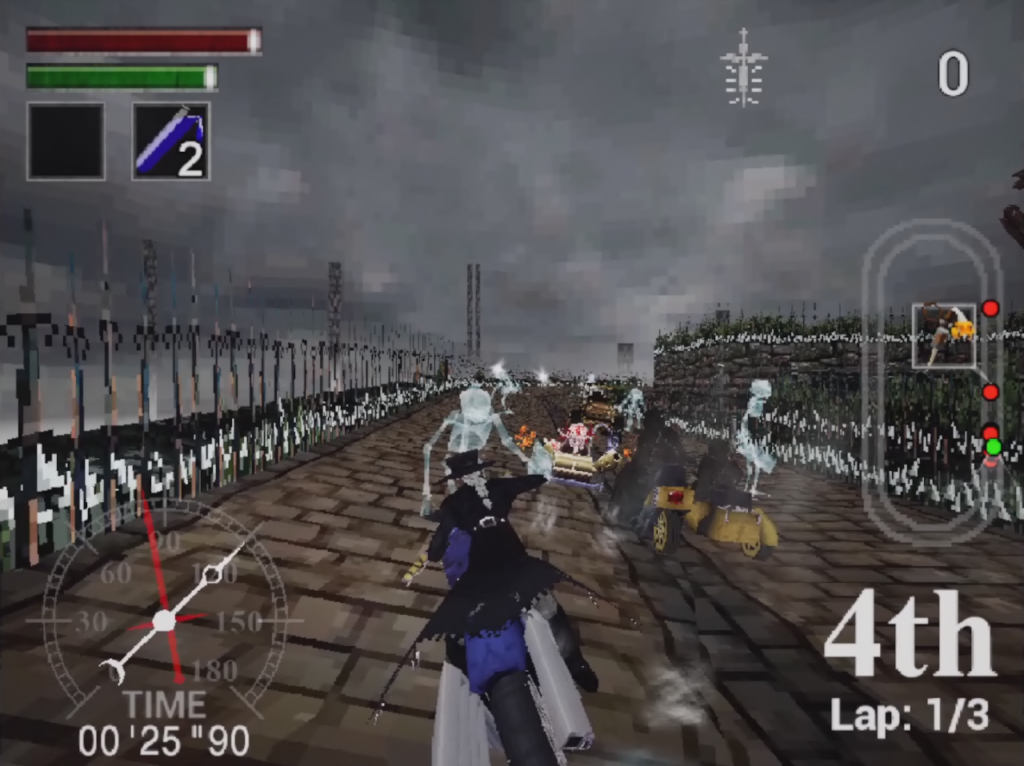
During my time with Nightmare Kart, I don’t observe any rubberbanding, the infamous kart racing mechanic where computer-controlled racers are given impossible off-screen boosts that allow them to keep pace with a skilled human driver. They don’t need it. It is simply impossible to keep up with an opposing driver who gains too large an Blood Droplets advantage. Instead of rubberbanding, Nightmare Kart’s computer-controlled opponents remain competitive through a pure numbers advantage.
Unusually for a kart racer, every participant in a race has a hit point meter, including the player character. When attacks from opponents or collisions with the track’s more dangerous monsters reduce their hit points to zero, that driver “dies” and is sent back a few feet on the track. They also drop their collected Blood Droplets which may be picked up by any other driver who passes through them.
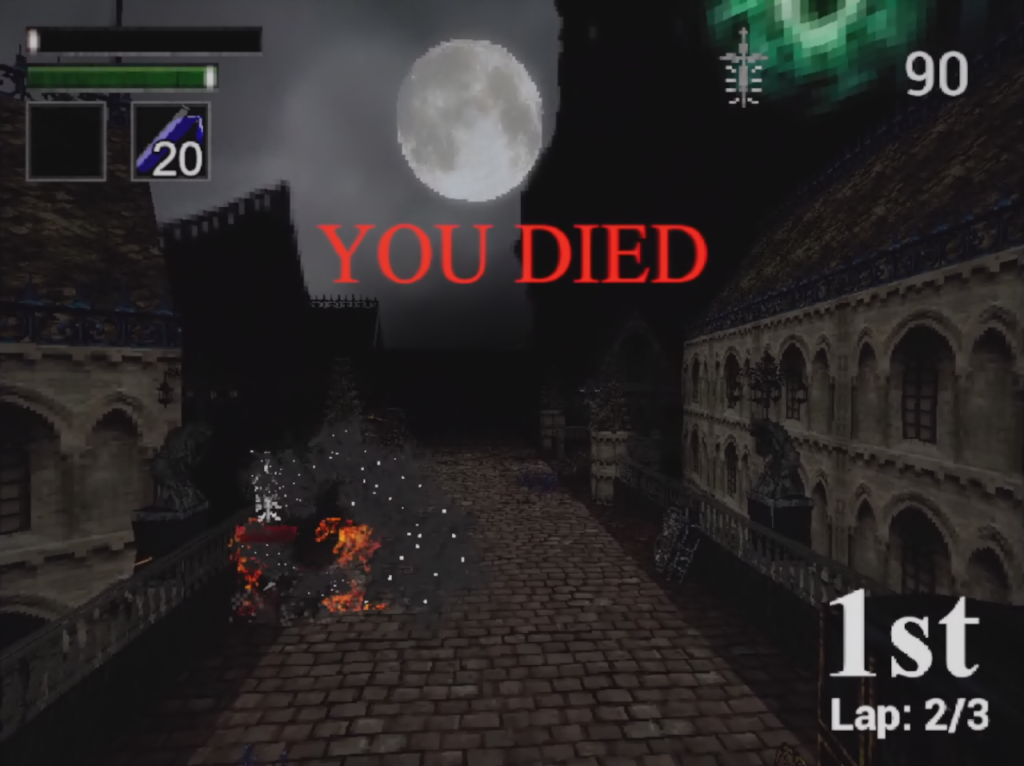
The possibility of claiming another driver’s Blood Droplets encourages aggressive play. While it’s possible to reach the Echo cap of 1000 through skilled hunting of a track’s monsters, it is more easily reached by killing another player and picking up their dropped Droplets instead. By the final lap,the racers vie amongst themselves to control the track’s Droplets and gain the greatest boost to their speed. The one who collects the most is the fastest and invariably the winner of the race.
Another familiar kart racing mechanic given a Bloodborne reimagining is powersliding. If I hold down the powerslide button as the player character enters a turn, that turn becomes sharper and smoother, giving them greater control over their turn while maintaining their speed. This is the familiar function of a powerslide. Kart racers typically reward skilled use of this technique with an immediate boost of speed. Nightmare Kart makes a different choice.
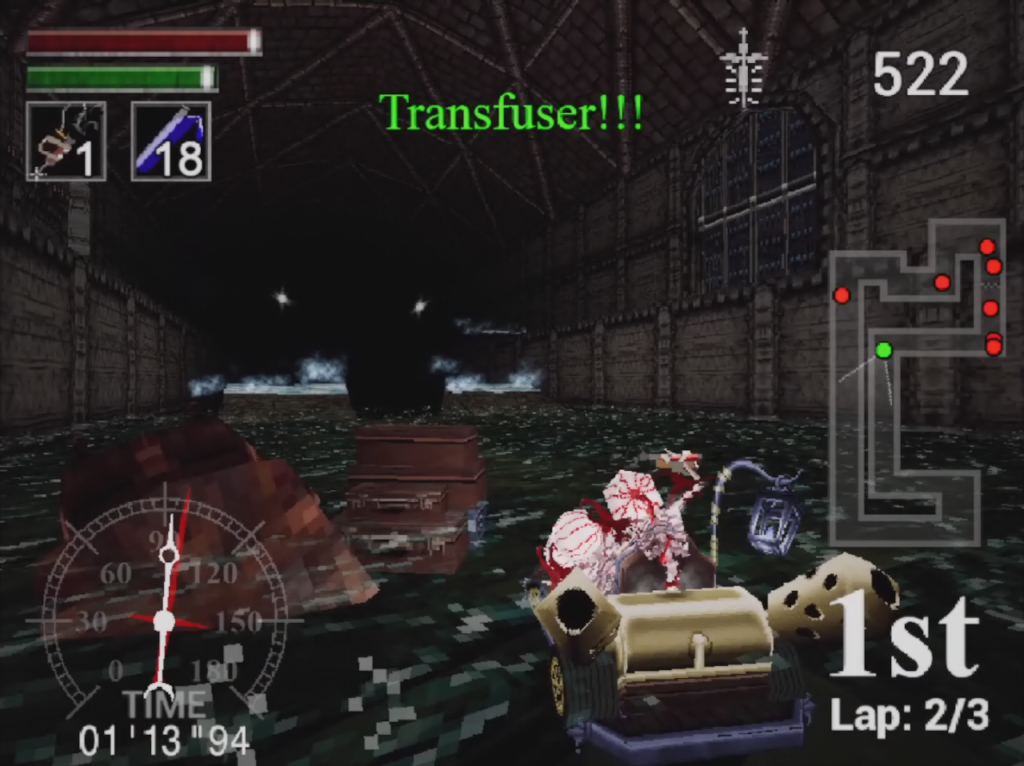
In addition to the weapons they collect from the track, each racer carries a number of Æther Vials. When used, these confer a small boost of speed to the driver’s kart. Smaller numbers of Æther Vials may be obtained from item pickups or by pressing the trick button when the kart is airborne but the main way to earn them is by powersliding. The longer a powerslide is held, the more vials are earned. Instead of an immediate boost of speed rewarding skillful play, Æther Vials let me choose more strategic times when to use an earned boost.
It’s tempting to use as many Æther Vials as possible to boost through each track’s many straightaways. This is dangerous. In addition to their health meter, each racer also has a stamina meter which drains with every use of an Æther Vial then quickly refills after a moment’s rest. If it empties completely, the racer spins out and becomes vulnerable to an opposing racer’s boost. Boosting into a racer in the vulnerable state executes a one-hit kill Visceral Boost and automatically transfers all of their Blood Droplets into the killer’s kart.
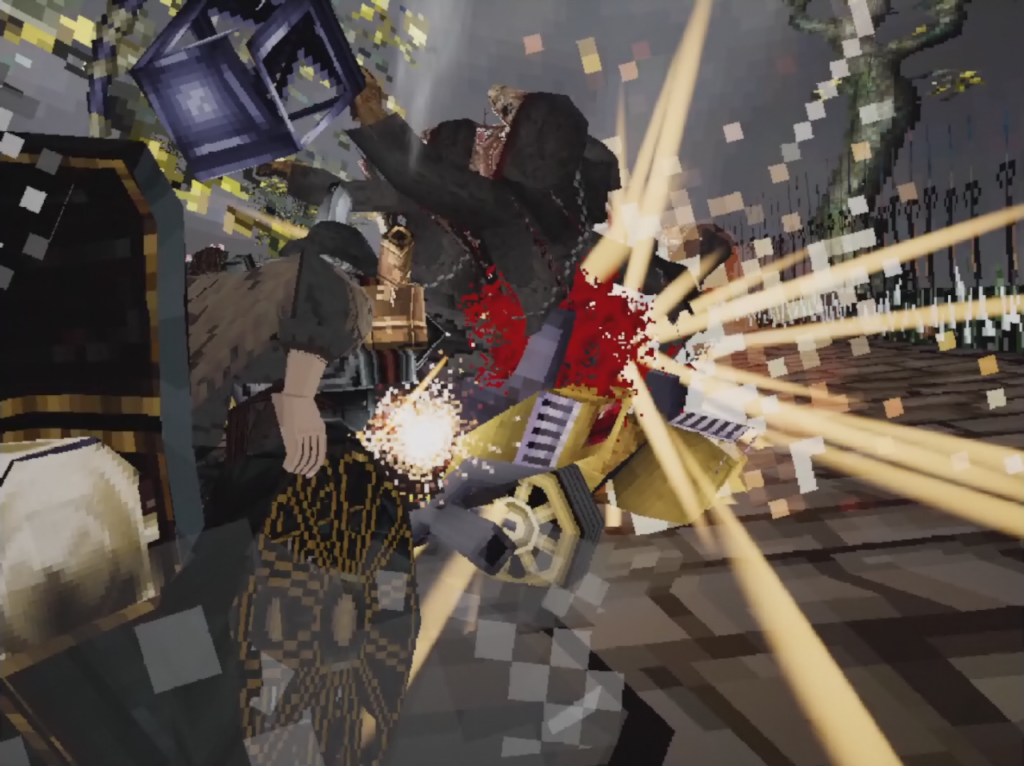
Visceral Boosts are the most difficult technique to complete. They require a mistake on one driver’s part and coincidental positioning and perfect timing from another to occur, but they are game changing. When I manage to perform one on another racer, especially if it’s a competitor in first or second place ahead of me, it’s immensely satisfying.
Skillful powersliding is where I derive the most satisfaction from kart racers. This may be why I struggle to enjoy Nightmare Kart as much as other kart racers. It’s not a problem of the powersliding itself, which is mechanically sound. The problem is few of Nightmare Kart’s tracks allow for extensive use of the technique. Most tracks primarily contain short, hard, ninety-degree turns that only allow for a brief powerslide before I must straighten the kart’s path out again for the next straightaway. The few tracks that do contain broader, sweeping curves are still difficult to powerslide on because the curves are too broad. Extended powerslides on these curves often send the driver directly into a wall, or worse, off a bottomless cliff to their death.

The track design in general seems to be where Nightmare Kart suffers most. Tracks are aesthetically pleasing, capturing Bloodborne’s gothic-Victorian style in convincing 32-bit polygonal graphics. It’s in their layout where they disappoint. Most are built on simple oval shapes with a few added turns so I feel like I’m doing more than repeatedly turning left. Only the ultimate course, a madcap race through a fading dreamworld that takes its cues from Mario Kart’s many incarnations of Rainbow Raid, feels like it wasn’t created by tweaking a basic oval.
There are more competition types than the standard race. The first is a Battle mode that pits two color-coded teams of four racers against one another in a traditional deathmatch. This mode takes the weapon-based combat to its logical conclusion. The first team to score an arbitrary number of kills on the opposing team wins. There are several variations on this mode, like a Last Hunter Standing round where every competitor has only one life, but they all play essentially the same.

The other mode is Capture the Flag and it is Nightmare Kart at its most miserable. This mode tasks drivers with racing to an orb of Insight in the middle of the track and then returning it to their own base to score a point. The problem is less the way the mode is designed than the main map that supports it. It’s huge and every turn in it looks the same, making it difficult to carry the Insight back to my base without constantly checking the minimap in the screen’s corner. Losing my place in the world for even a moment, easy enough to do in the chaos of a free-for-all kart battle, can get me hopelessly lost. The track’s narrow draw distance exacerbates the problem.
Nightmare Kart’s primary mode is its Campaign. After naming the Hunter player character and choosing whether they have a masculine or feminine voice—their avatar is the same either way—they embark on a rough retelling of Bloodborne’s plot.
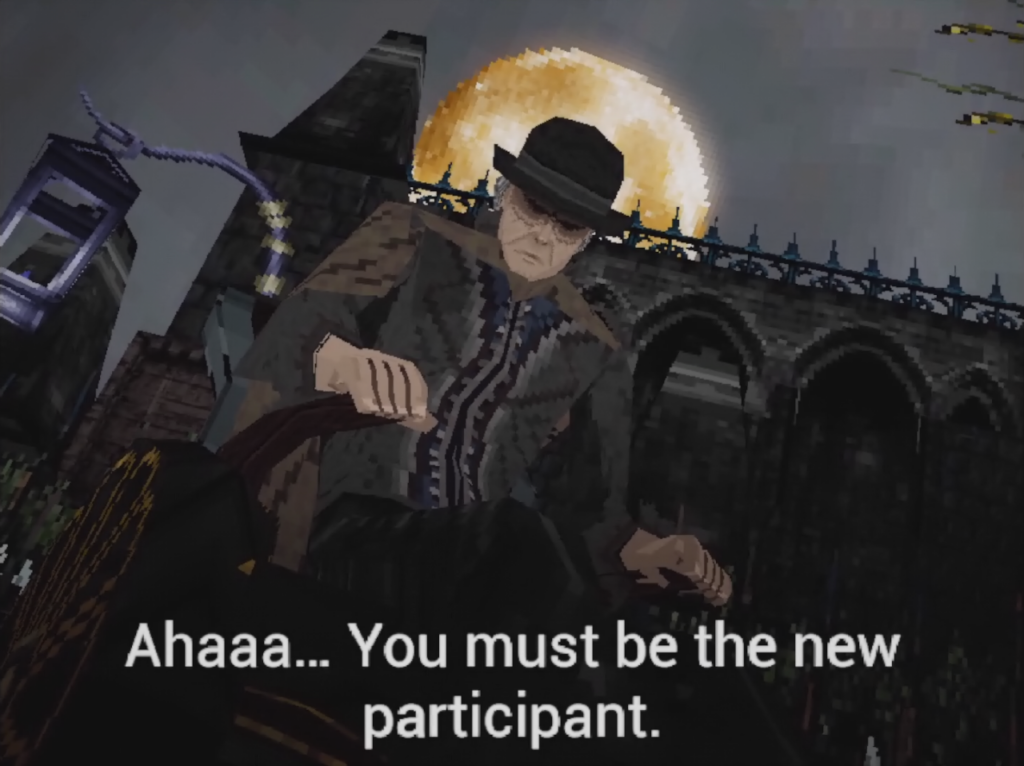
Most of Bloodborne’s events are retold with simple cutscenes and short paragraphs of text expositing the events that take place between each race. Experienced Bloodborne players will be able to follow this plot and may be tickled by how it has been warped to fit the strictures of a kart racer. Players who have never played Bloodborne may find the plot inscrutable; even with its details exposited directly to me, it still relies on a lot of missing context to be fully understood.
The campaign takes me through thirteen levels of different races, battles, and a single infuriating round of Capture the Essence. A few levels are even special boss fights against one of the world’s cursed Hunters. The first two are basic, essentially one-on-one races that end in one-on-one deathmatches. The third boss fight is the most elaborate, taking one of Bloodborne’s most inexplicable encounters and reimagining it as a race through an endless hallway of teleporting mirrors. It is Nightmare Kart’s design at its most ambitious and successful. It’s so good it makes the other boss fights into disappointments.
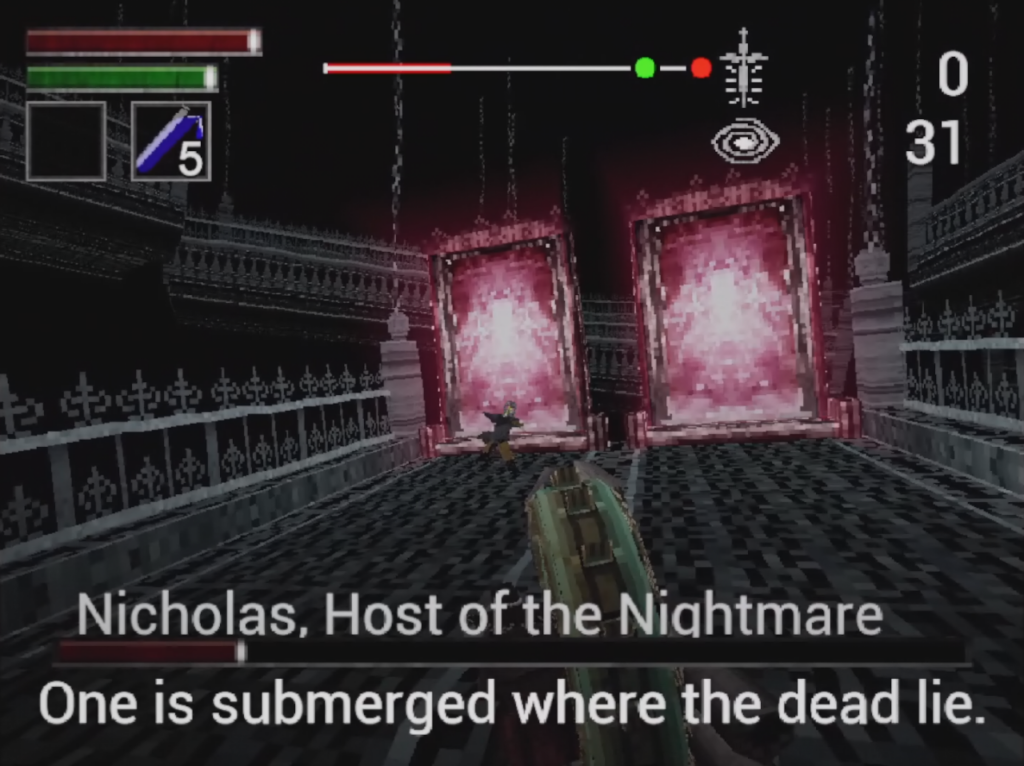
When I finish the campaign, it loops back onto itself into New Game +1. This sends my Hunter back to the first level to face the campaign again at an increased difficulty. There are multiple reasons to do this. The first is a hidden ending and boss fight which takes some extra effort to unlock. Getting top placement in a race or finishing a boss fight under a certain time limit also rewards the Hunter with Insight. There’s forty in total to earn and the more Insight obtained, the more racers and karts become available to use in Free Play mode.
Free Play doesn’t feel as refined as the campaign. It offers a bevy of difficulty options and race tweaks to transform the next match into whatever configuration I like. It offers so many they don’t even fit into Nightmare Kart’s default resolution. Despite this, all of the options are here. This is most important because Free Play is where I come to play the most essential of kart racer modes, local split-screen multiplayer—and only local split-screen, as Nightmare Kart does not support online multiplayer at the time of this writing.
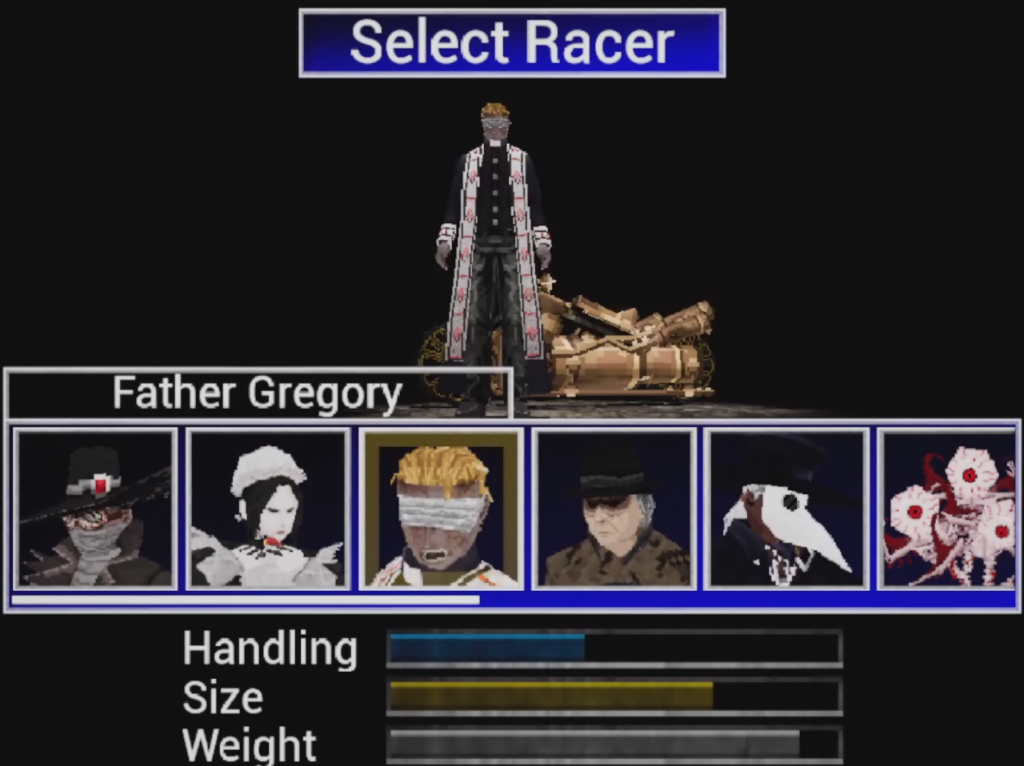
Players will have little difficulty playing a multiplayer match with their friends if they have the needed hardware. Nightmare Kart is playable with a keyboard though it does not feel like the intended control method. I was delighted to plug my Xbox controller into my PC and find this videogame already fully configured for its inputs. The campaign even begins with a tutorial level guiding me through the function of every button on the gamepad. It’s about as pick-up-and-play as it’s possible for a PC videogame to be, which is a boon for the typically beginner-friendly kart racing genre. Players eager for some local multiplayer mayhem only need a handful of controllers and the know-how to connect them to their PCs to begin.
Perhaps predictably due to its nature as a fangame, Nightmare Kart will be most satisfying to fans of Bloodborne. As this is a large group and many of them are ravenous in their devotion to FromSoftware’s beast hunting bloodbath, Nightmare Kart should satisfy many. I expect these superfans’ main issue will be tedious squabbling about which of their favorite omitted areas and bosses should have been included.
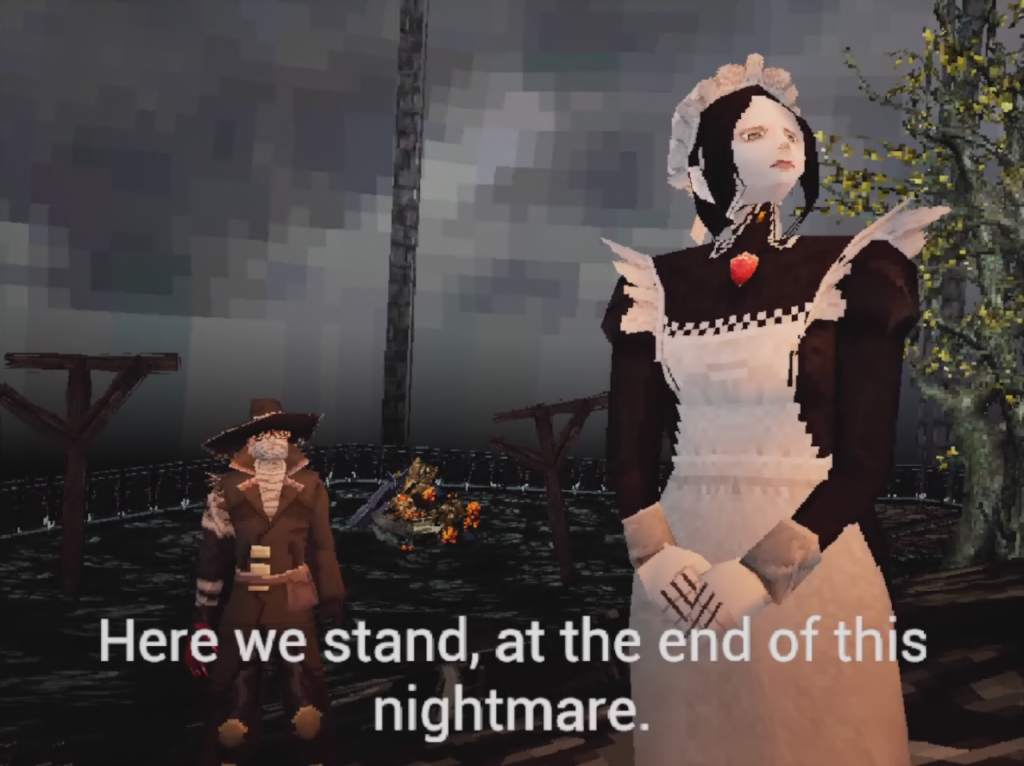
To other players, Nightmare Kart is adequate at best. I appreciate how they’ve taken Bloodborne’s action-RPG mechanics and reimagined them to suit a kart racer, and often in clever and innovative ways. These ideas are held back by the track design. They simply don’t support the great kart racer that the mechanics imply. Courses are few in number and are mostly indistinguishable from each other. They contain plain layouts with many sharp, ninety-degree turns. They offer few thrills and fewer challenges. The foundation exists here for a great kart racer if there’s another attempt with larger and more imaginative tracks. Those tracks aren’t here. What is here is notable mostly for its fangame connections to Bloodborne. It is not an entertaining videogame on its own merits.
Nightmare Kart may be downloaded from itch.io or added to your Steam library from its storefront page. It is free, though its developer appreciates donations to their Ko-Fi.